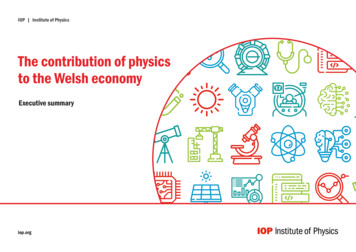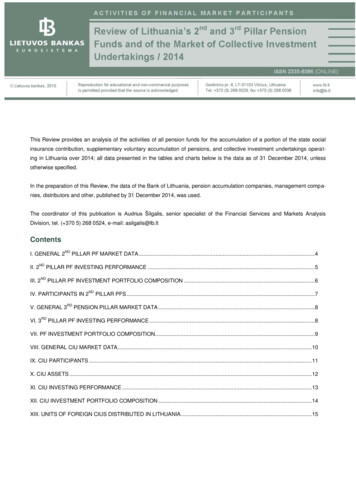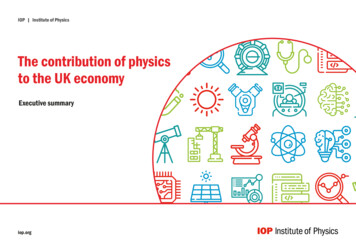
Transcription
IOP Institute of PhysicsThe contribution of physicsto the Welsh economyExecutive summaryiop.org
IOP Institute of PhysicsPhysics is a foundation stone for the Welsh economy and theindustries which use physics are both important and highlyproductive. In Wales, physics-based industries (PBIs) employ morethan 113,100 full time equivalent (FTE) employees nationwide andcontribute 10% of national gross domestic product (GDP). Labourproductivity in the sector sits at 64,828 per worker, per year.A project commissioned by the Institute of Physics (IOP) andconducted by the Centre for Economics and Business Research (CEBR)shows the performance and growth of the sector between 2010-2019.Read the full report at /physics-and-economy.What is the physics sector?Physics-based industries (PBIs) are industries whoseenterprises:A) demonstrate ongoing research and development (R&D)which consistently makes use of physics knowledge (andthe R&D activity can be expected to significantly affectthe fortunes of businesses within the industry), orB) where underlying technology supporting the industryrequires significant physics knowledge for continued operation.The largest parts of the physics sector are Physics manufacturing(which includes, but is not limited to, the production of a wide rangeof goods, from fibre optic cables to aircraft and medical equipmentto support civil and defence objectives) and physics science andtechnology (which includes, but is not limited to, technical testingand analysis and practical scientific consultancy). Physics machineservices and sales, along with medical equipment sales, representdownstream servicing and sales of the goods physics manufacturingcreates. The energy, oil and gas extraction and telecoms industries aremajor standalone industries with physics at their heart.iop.orgIn 2019 *All figures are rounded.Employment - Full time equivalents (FTEs - thousands)19.5%Total: 113.156.5%5.6%6.6%Number of enterprises (thousands)4.9% 4.2% 2.7%Total: 12,17068.9%19.4%6.1%1.7%1.3%1.4%Gross value added - GVA ( bn)15.1%Total: 7.346.5%4.5% 13.5%13.1%Turnover ( bn)7.9%1.2%3.9%3.4%Total: 26.758.1%4.5% 18.0%3.7%IndustryPhysics science & technologyTelecomsPhysics manufacturingEnergy production,transmission & distributionPhysics machine servicesPhysics waste & recoveryOther6%1.8%
IOP Institute of PhysicsThe physics sector is highly productive and a significantcontributor to the Welsh economyIn 2019 GVA contributionTurnover 7.3bn 26.7bnThe physics sector directly generated 7.3bn Gross Value Added (GVA), 10% of total Welsh GDP.The physics sector generated 26.7bn in turnover.National breakdownNational breakdownThis figure is greater than turnover in NorthernIreland, but lags behind Scotland and England.Welsh PBI GVA contribution is consistent with that in England and Northern Ireland:English PBIs contributed 190bn in GVA - 10%of total English GDP.Scottish PBIs contributed 28bn in GVA – 17%of total Scottish GDP.Welsh PBIs contributed 7.3bn in GVA – 10%of total Welsh GDP.Northern Irish basedPBIs contributed 3.5bnin GVA – 7% of totalNorthern Irish GDP.English PBIs generated 533bn in turnover.Scottish PBIs generated 64bn in turnover.UK Total: 229bn - 11%Welsh PBIs generated 26.7bn in turnover.Northern Irish PBIs generated 10bn in turnover.Spotlight on industrySectoral comparisonThe biggest PBI sub-sector was physicsmanufacturing, which contributed 3.4bnin GVA, followed by physicsscience & technology( 1.1bn), telecoms ( 0.99bn)and energy production,transmission & distribution( 0.96bn).The physics sector generated more annual GVAthan the Construction ( 1.2bn), Transport andStorage ( 2.3bn), and Retail ( 2.9bn) sectorscombined.iop.org 1.2bnConstruction 2.3bnTransport andstorage 2.9bnRetailUK Total: 634bnSpotlight on industryThe sector with the greatest turnover is physicsmanufacturing ( 15.5bn), with a 57% share ofturnover across the decade. This is followed byenergy production, transmission and distribution( 4.8bn).Sectoral comparison PBI turnover ( 26.7bn) is more thanthree times the combined turnover ofthe construction ( 2.9bn) and transportand storage ( 5.1bn) sectors.PBIs have double the turnover ofthe retail sector ( 13bn).Labour productivity 64,828Labour productivity sat at 64,828 per worker,per year.This is the lowest of the UK nations. Scotland - 129,000England - 81,300Northern Ireland - 71,966
IOP Institute of PhysicsThe physics sector has a large numberof enterprisesIn 2019 Scotland had a total ofThere were 12,170 physics enterprises operatingin Wales – 12% of all Welsh enterprises.businesses in the physics sector(15% of all Scottish enterprises)27,235The majority of physics enterprises are SMEs(99%), which employ a maximum of 9 people.This is line with trends across the wider UKphysics sector.Northern Ireland had a total of 5,28592% (11,185) of enterprises were categorised as micro companies.7% (800) of enterprises were small (10-49 employees).1% (180) were medium (50-249 employees) or large (250 ).Wales had a total of12,170By comparison, in the wider Welsh economy 89% of firms are micro enterprises.9% are small.The remaining 2% are medium or large.89%iop.orgbusinesses in the physics sector(12% of all Welsh enterprises)9%England had a total of305,445businesses in the physics sector(13% of all English enterprises)Sectoral comparison:The size of physics sector enterprises is similar to the widerWelsh average. businesses in the physics sector(7% of all Northern Irish enterprises)2%
IOP Institute of PhysicsThe physics sector is a significant employer in WalesIn 2019 Total employmentCompensation of employees113,100 FTEs 36,089National breakdownThese figures are consistent with the other UK nations:Sectoral comparisonThis is a strong figure compared to the retail sector( 17,162 on average), and is similar to the Transportand Storage sector ( 35,810).The sector directly employed more than 113,100 FTEs.This accounted for 10% of total Welsh employment.English PBIs directly employed 2.338m FTEs– 10% of total English employment.Scottish PBIs directly employed 220,000 FTEs– 10% of total Scottish employment.Welsh PBIs directly employed 113,138 FTEs– 10% of total Welsh employment.Northern Irish PBIs directly employed 48,842FTEs – 7% of total Northern Irish employment.Average employee compensation.National breakdownEmployee compensation in Wales lags behind that in Englandand Scotland:English PBIs had a total of 98bn employeecompensation - 41,990 per FTE worker on average.Scottish PBIs had a total 10.4bn employeecompensation - 47,000 per FTE worker on average.Welsh PBIs had a total of 4.1bn employeecompensation - 36,089 per FTE worker on average.Northern Irish PBIs had a total of 1.7bn employeecompensation - 34,791 per FTE worker on average.iop.org
IOP Institute of PhysicsThe physics sector grew across the decadeBetween 2010-2019 GVATurnoverLabour productivity20%36%10%GVA contributed by Welsh PBIs rose by 20%.This is similar to growth in England, and muchhigher than seen in Scotland.Welsh PBIs experienced a turnovergrowth of 36%, from 19.6bn in 2010.Labour productivity increasedby 10% across the decade from 58,855 to 64,828.The GVA generated by English PBIsgrew by 23%This is a greater rise than the UK-widePBI turnover growth rate (24%).The GVA generated by Scottish PBIsgrew by 0.5%EmploymentThe GVA generated by Welsh PBIsgrew by 20%8%The GVA generated by Northern IrishPBIs grew by 47%Number of enterprises47%The number of physicsenterprises grew by 47%.iop.orgEmployment in the physics sector grew by 8%.Compensation of employees 4.083bnCompensation of employees (COE) grew by 41%across the decade, from 2.896bn to 4.083bn.This was a much higher growth rate comparedto employment, meaning that average employeecompensation increased by 30% (from 27,729to 36,089).Compared to other nationsAverage English COE/FTE increased from 36,103to 41,990 (16% across the decade).Average Scottish COE/FTE increased from 43,000to 47,000 (9% across the decade).Average Welsh COE/FTE increasedfrom 27,711 to 36,089 (30%across the decade).Average Northern Irish COE/FTEincreased from 29,304 to 34,791(19% across the decade).
More information and the methodologyThe Institute of Physics (IOP) worked with the Centre of Economic and Business Research (CEBR) to quantify the contribution of PhysicsBased Industries (PBIs) between 2010-2019 across the Welsh economy. For the full findings and methodology, see ysics-and-the-Economy-Wales.pdf.The Institute of Physics (IOP) is the professional body and learned society for physics in the UK and Ireland. It seeks to raise publicawareness and understanding of physics, inspire people to develop their knowledge, understanding and enjoyment of physics andsupport the development of a diverse and inclusive physics community. As a charity, it has a mission to ensure that physics deliverson its exceptional potential to benefit society.The Institute of Physics is a charity registered in England and Wales (no. 293851) andScotland (no. SC040092).iop.org
The Institute of Physics (IOP) is the professional body and learned society for physics in the UK and Ireland. It seeks to raise public awareness and understanding of physics, inspire people to develop their knowledge, understanding and enjoyment of physics and support the development of a diverse and inclusive physics community.










